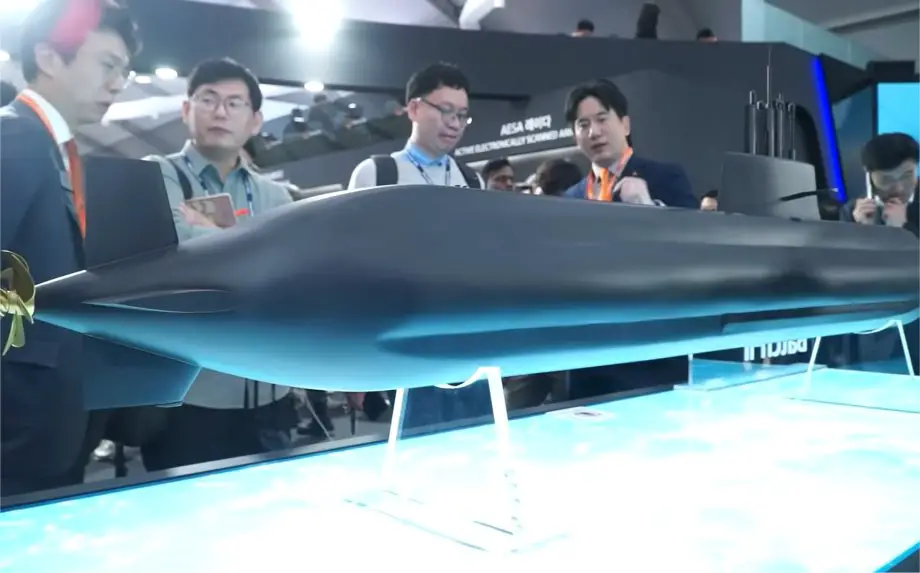Breaking news
Hanwha Ocean signs agreement with German firm Gabler to strengthen its submarine maintenance capabilities.
According to information published by Hanwha Ocean on January 10, 2024, the firm is stepping up its capabilities in the Maintenance, Repair, and Overhaul (MRO) sector, in preparation for submarine exports and the upgrade of the Republic of Korea Navy’s submarine performance.
Follow Navy Recognition on Google News at this link
 A model of the Jangbogo class Batch II submarine at ADEX. (Picture source: Army Recognition Group)
A model of the Jangbogo class Batch II submarine at ADEX. (Picture source: Army Recognition Group)
Hanwha Ocean's Vice President, Kwon Hyuk-Woong, discussed strengthening cooperation with the German defense company, Gabler, over two days starting on the 8th. They signed a technical agreement to enhance cooperation in the maintenance, repair, and overhaul of submarine optron-masts.
Subsequently, Hanwha Ocean expanded its collaboration with Gabler, which holds key technologies in submarine optron-masts. Optron-masts, installed on the upper structures of submarines, include periscopes, radar, and communication masts.
Gabler recently established its Korean branch, Gabler Korea, further strengthening its collaboration with Hanwha Ocean. This technical agreement expands the license scope related to optron-mast technology and aims to enhance cooperation synergies, including efficient parts supply through Gabler Korea and technical cooperation in the MRO of the Republic of Korea Navy's submarines.
Hanwha Ocean is striving to participate in the post-export MRO business of warships, in response to the increasing global demand for defense products. The recent establishment of an MRO business organization highlights the strategic importance of this sector.
The firm, having independently designed and developed a 3,000-ton submarine, achieved an 80% domestic production rate for the Jangbogo-III Batch-II submarine platform and major equipment.
Jangbogo-III Batch II
Initiated in March 2023 and slated for delivery to the Republic of Korea (ROK) Navy by 2026, this advanced submarine is a trailblazer in diesel submarine technology and is considered a global leader in undersea navigation capabilities.
Weighing 3,600 tons and measuring approximately 90 meters in length, the Jangbogo-III Batch-II is notably larger than its predecessors. This size increment is partly to accommodate an enhanced vertical launch system (VLS), a notable upgrade from the first-generation Jangbogo-I.
A key feature of the Batch-II is its enlarged launch tubes, tailored for deploying submarine-launched ballistic missiles (SLBM). These tubes have been resized to support various missile systems, demonstrating the submarine's versatility to meet different naval requirements.
Internally, the Jangbogo-III Batch-II is designed to house a crew of 50, spread across two decks—a significant shift from the single-deck layout of the Jangbogo-I and II models.
This dual-deck design allows for better organization of living spaces and operational areas, such as the combat control center (CCC).
Equipped with diesel-electric and air-independent propulsion (AIP) systems, the Jangbogo-III Batch-II exhibits an impressive operational range. The AIP system, which generates hydrogen and oxygen by breaking down water, enables the submarine to remain submerged without surfacing for oxygen, thus enhancing its stealth and endurance. This model can stay underwater for over 20 days, setting a world record for continuous operation among diesel submarines.
Although nuclear submarines benefit from extended operational capabilities due to their fuel type, diesel submarines, like the Jangbogo-III Batch-II, typically require surfacing for oxygen intake. However, the Batch-II's AIP system overcomes this limitation by autonomously producing oxygen underwater, a capability possessed by only a few entities worldwide.
The Jangbogo series showcases South Korea's naval evolution, with the Jangbogo-I at approximately 1,260 tons, the Jangbogo-II at 1,800 tons, and the Jangbogo-III Batch-I at around 3,000 tons, each iteration representing a leap forward in the nation's maritime defense capabilities.























